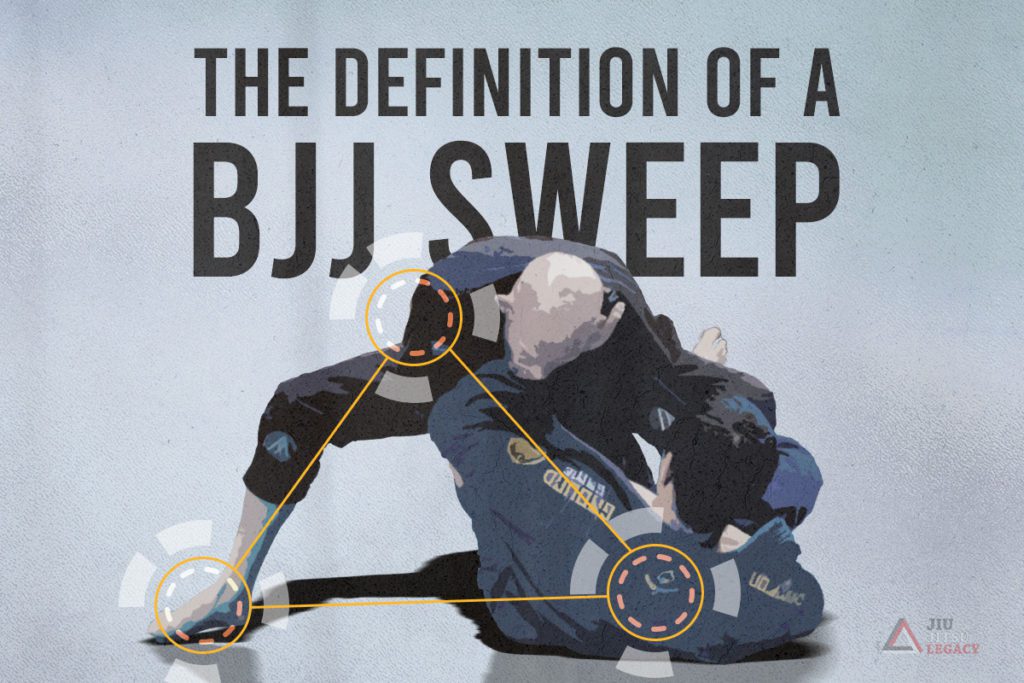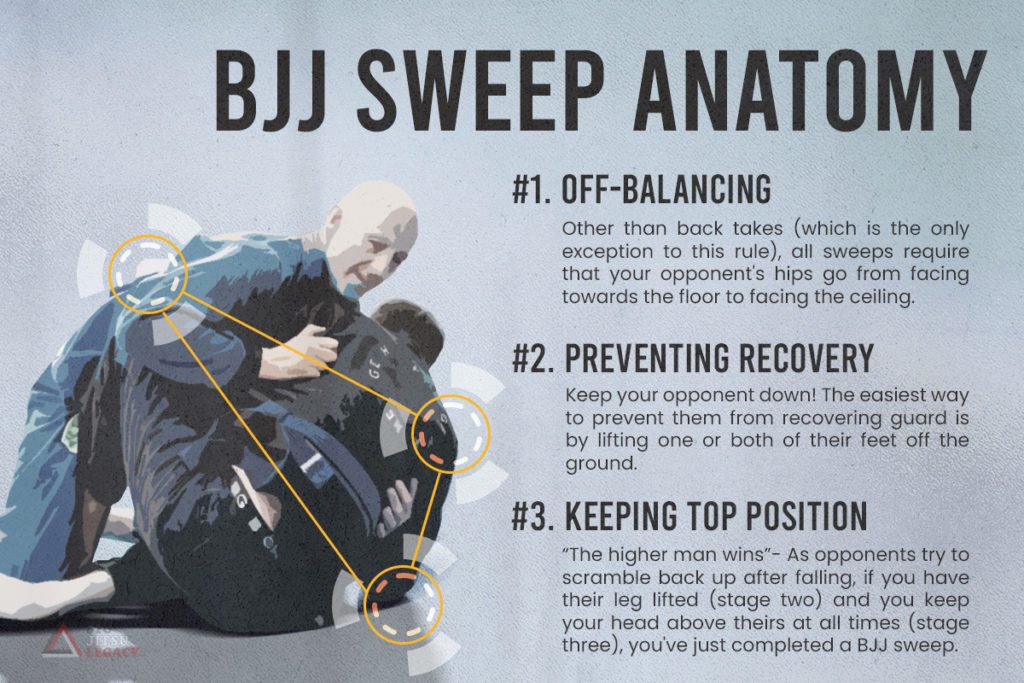OK – I know what you’re thinking: this article’s title is a bit hyperbolic. But have no doubt, if you understand the basic principles of sweeping in BJJ, you’ll be able to reverse just about anyone! The mechanics of it are relatively simple, as we’ve all only got a pair of feet and a pair of arms to stop sweeps! Keep reading to learn how to make these bases belong to us and put ourselves on top of our competition!
The Definition of a Sweep in BJJ

What is a BJJ sweep? You might suspect that any technique that gets you on top of someone, when you’ve started off with your back on the ground, is a sweep in Jiu Jitsu. While this common-sense approach to the definition is completely understandable, according to the rules of BJJ, not every situation when you end up on top will be considered a sweep!
For a move to be considered a BJJ sweep, you need two things:
- The technique must be initiated from a guard, which means your legs are positioned in between you and your opponent.
- Once they fall down, you must get up and stay in a top position for at least 3 seconds for the sweep to count and for 2 points to be awarded.
Anytime you end up on top from a position that isn’t a guard in Jiu Jitsu, you have not earned a sweep, but rather a reversal. Reversals are great! No one wants to be on the bottom of a side control or mount! However, our sport is a sport and as such comes with some relatively arbitrary or arcane rules. Reversals are not worth any points in any major competition ruleset. You’ll be in a more advantageous position, but you’ll need to keep working to overcome any point deficit you’re facing!
Stages of a BJJ Sweep

Every sweep progresses through three stages. First, you must put your opponent on their back. Second, you must get off of your back while keeping them on their back. Third, you must remain on top for at least 3 seconds. It’s a rare sweep that breaks each of these stages into discrete segments, with many sweeps relying on multiple of these steps overlapping in time. In order to boost your sweep success rate, you’ll want to be prepared to deal with your opponent’s response to each of these 3 stages.
1. Off-Balancing
There are dozens of ways to sweep a person, but the commonality between all of them is you are taking turning their hips over. Other than back takes (which represent the single exception to this rule), all sweeps require that your opponent’s hips go from facing towards the floor to facing the ceiling.
This can be accomplished by rotating them right or left, pushing them backwards, or even by rolling them forward.
2. Preventing Recovery
Once an opponent is down, it is time for stage two – keeping them down. Any determined opponent will immediately try to recover their position, so you will need to be prepared to shut down their efforts. The easiest way to prevent them from recovering guard is by lifting one or both of their feet off the ground.
If you doubt how effective this is, try it out yourself! Sit on the ground and, without putting your feet or knees on the ground, try to stand up. Just reading these instructions is probably sufficient to convince you how effective this basic principle is!
3. Getting on Top & Staying on Top
The final stage of completing a sweep is getting yourself on top. Here we can rely on the old adage from wrestling – the higher man wins. As opponents try to scramble back up after falling, if you have their leg lifted (stage two) and you keep your head above theirs at all times (stage three), you’ve just completed a BJJ sweep. Congratulations!
Basic Principles of BJJ Sweeps: How to Sweep Anyone?
Let’s get a bit more technical now and explore the formula that will help you sweep anyone. First of all, recall that you’ll need to start from a guard. While reversals from side control or mount are vital skills for any jiujitsero, they are not sweeps.
Once you’ve established a guard, it is time to think about getting a BJJ sweep. As with many techniques, sweeps all starts with your grips. Regardless of the guard you’re in, you will want to accomplish two things with your grips – disrupt your opponent’s posture while controlling their arm’s range of motion.
When you’re controlling your opponent’s arms, try to either pin their arm against one of your bodies or stretch it away far away from their body. Both of these extremes will open up options for attacks and sweeps.
Once you’ve limited their ability to use their arms for balance, you need to begin turning their hips over. The hips are an important area to focus on as this is the natural center of gravity. Once you’ve turned someone’s hips over, the rest of their body is sure to follow.
There are several ways to turn your opponent’s hips over: you can push or pull their shoulders, you can push or pull the hips directly, or you could push or pull their legs. As long as you can get one of these three zones (shoulder line, hip line and knee line) out of alignment, you’ll see your opponent falling.
Once you have the balance broken, and you’ve identified a zone to manipulate, you’ll need to choose whether you’ll commit your efforts to that zone to make it move, or whether you’ll make enough space to get up yourself and manipulate the zone from there.
Summary
Getting a BJJ sweep is not hard, you just have to know why they work. Starting from the guard, you need to break their posture, control their arms, and then turn their hips over. Remember that each sweep requires off-balancing your opponent to put them on their back, keeping them on their back while you get up yourself, and maintaining the top position for 3 seconds!

Evan is nomadic brown belt, currently living in Germany. He enjoys pressure passes and tacos.

2